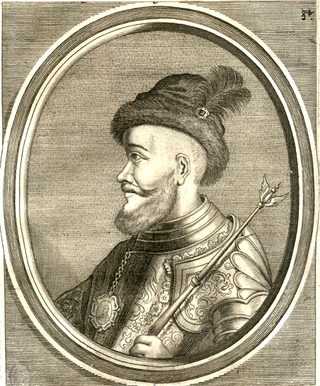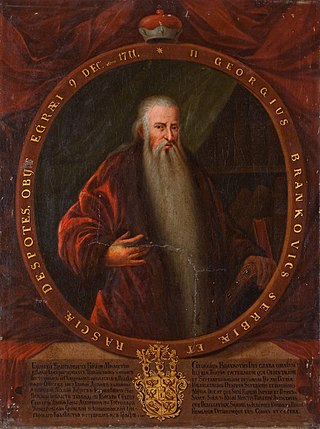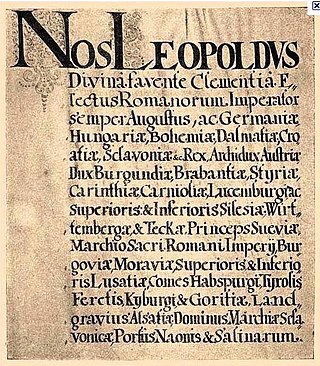
Hans Heinrich August Gábor Thyssen-Bornemisza de Kászon, Baron Thyssen, was a Dutch-born Swiss industrialist and art collector. A member of the Thyssen family, he had a Hungarian title and was heir to a German fortune.

The King of Hungary was the ruling head of state of the Kingdom of Hungary from 1000 to 1918. The style of title "Apostolic King of Hungary" was endorsed by Pope Clement XIII in 1758 and used afterwards by all monarchs of Hungary.

Emeric Thököly de Késmárk was a Hungarian nobleman, leader of anti-Habsburg uprisings like his father, Count István Thököly, before him. Emeric was Prince of Upper Hungary, an Ottoman vassal state, from 1682 to 1685, and briefly Prince of Transylvania during the year 1690. Having formed an alliance with the Turks, Thököly assisted the Ottoman Empire at the Battle of Vienna in 1683 and led the Turkish cavalry at the Battle of Zenta. Refusing to surrender to Habsburg Emperor Leopold I, Thököly lost his principality of Upper Hungary and finally retired to Galata, near Constantinople, with large estates granted him by Mustafa II.

Isabella Jagiellon was the queen consort of Hungary. She was the oldest child of Sigismund I the Old, King of Poland, and his Italian wife Bona Sforza.
The Early Modern Times in Romania started after the death of Michael the Brave, who ruled in a personal union, Wallachia, Transylvania, and Moldavia – three principalities in the lands that now form Romania – for three months, in 1600. The three principalities were subjected to the Ottoman Empire, and paid a yearly tribute to the Ottoman Sultans, but they preserved their internal autonomy. In contrast, Dobruja and the Banat were fully incorporated into the Ottoman Empire.

Maria Laskarina was a Greek Queen consort of Hungary by marriage to Béla IV of Hungary. She was the daughter of Theodore I Laskaris and Anna Komnena Angelina.

The Principality of Transylvania was a semi-independent state ruled primarily by Hungarian princes. Its territory, in addition to the traditional Transylvanian lands, also included the other major component called Partium, which was in some periods comparable in size with Transylvania proper. The establishment of the principality was connected to the Treaty of Speyer. However, Stephen Báthory's status as king of Poland also helped to phase in the name Principality of Transylvania. Although the principality was essentially independent, it existed as an Ottoman vassal state for the majority of the 16th and 17th centuries, overseen by Ottoman Turkish sultans but ruled by Hungarian princes. At various points during this period, the Habsburgs also exerted a degree of suzerainty in the region.

Michael Apafi was Prince of Transylvania from 1661 to his death.

Michael Apafi was the son of the Hungarian Michael I Apafi and Anna Bornemisza. Following his father, he was Prince of Transylvania from 10 June 1690 to 1699.

Agnes of Antioch, also known as Anna of Antioch and Anne de Châtillon, was Queen of Hungary from 1172 until 1184 as the first wife of Béla III.

Henriette Marie, Princess Palatine was a daughter born to Elizabeth Stuart of Bohemia and Frederick V of the Palatinate. Before her death, she was the wife of Sigismund Rákóczi.

Maria Christina of Austria, was a Princess of Transylvania by marriage to Sigismund Báthory, and for a period in 1598 elected sovereign Princess regnant of Transylvania.

The Principality of Transylvania, from 1765 the Grand Principality of Transylvania, was a realm of the Hungarian Crown ruled by the Habsburg and Habsburg-Lorraine monarchs of the Habsburg monarchy and governed by mostly Hungarians. After the Ottomans were ousted from most of the territories of medieval Kingdom of Hungary, and after the failure of Rákóczi's War of Independence (1703–1711), the Habsburg dynasty claimed the former territories of the Principality of Transylvania under the capacity of their title of "King of Hungary". During the Hungarian Revolution of 1848, the Hungarian government proclaimed union with Transylvania in the April Laws of 1848. After the failure of the revolution, the March Constitution of Austria decreed that the Principality of Transylvania be a separate crown land entirely independent of Hungary. In 1867, as a result of the Austro-Hungarian Compromise, the principality was reunited with Hungary proper.
Farkas Bethlen de Bethlen was a Hungarian noble and chronicler in the Principality of Transylvania, who served as Chancellor of Transylvania from 1678 to 1679.

Đorđe Branković was a Transylvanian Serb diplomat, writer, and self-proclaimed descendant of the medieval Serbian Branković dynasty. He served as the agent representing the ruler of Transylvania at the Ottoman Porte. In 1680, he moved to Wallachia, whose ruler sent him as an emissary to the Habsburg Emperor Leopold I in 1688. That year, the emperor conferred the title of Imperial Count on Branković. After Habsburg troops captured parts of Serbia from the Ottoman Empire during the Great Turkish War, Branković attempted to restore the medieval Serbian state with him as its hereditary ruler. His venture failed in its inception, and Habsburg authorities arrested him in 1689. He lived on as a captive in Vienna and Cheb, though he was not held in a prison. He wrote the Slavo-Serbian Chronicles, which was influential in the development of early modern Serbian historiography.

The Diploma Leopoldinum was a legal document which determined the basic principles of the government of the Principality of Transylvania within the Habsburg Empire. The diploma was drafted by Miklós Bethlen, Chancellor of Transylvania. The Holy Roman Emperor, Leopold I, sanctioned it in Vienna on 16 October 1690. The diploma announced on 4 December 1691. The diploma restored civil administration in the principality, and confirmed the traditional liberties of the Three Nations of Transylvania, including the freedom of the four "received" religions.
Sava II Branković, St. Sava II Branković or Sabbas Brancovici was a hierarch of the Romanian Orthodox Church who was canonized for opposing the oppression of the Roman Catholic Church, the Calvinists, and the Ottoman Empire. His youngest brother was Đorđe Branković who spent three decades in jail without being charged for any crime. Today Sava II Branković is venerated as the Metropolitan of Transylvania, and Confessor of Romania, his feast day is on the 24th of April.
Pál Bornemissza was the Roman Catholic bishop of Transylvania in the Kingdom of Hungary from 1553 and 1556. King Ferdinand I appointed him to the episcopal see after years of vacancy, although the Transylvanian nobles had proposed an other candidate, Márton Kecseti. Bornemissza could not stop the spread of Reformation in his diocese and he left Transylvania in 1554. Two years later, he abdicated the bishopric. After his abdication, the Transylvanian bishopric was left vacant for more than 100 years.
Mihály Teleki, was Chancellor of Transylvania and adviser to Prince Michael I Apafi.















